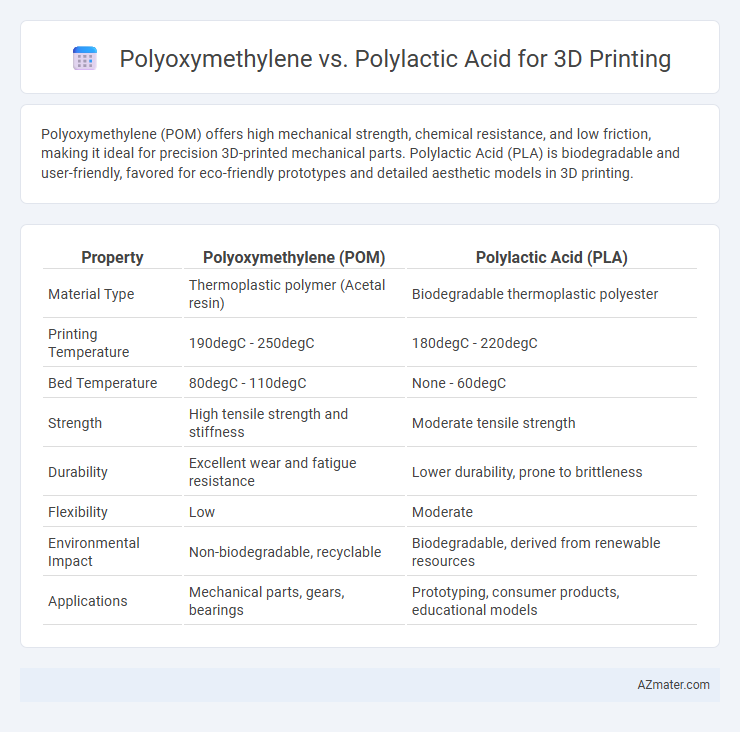Polyoxymethylene (POM) offers high mechanical strength, chemical resistance, and low friction, making it ideal for precision 3D-printed mechanical parts. Polylactic Acid (PLA) is biodegradable and user-friendly, favored for eco-friendly prototypes and detailed aesthetic models in 3D printing.
Table of Comparison
| Property | Polyoxymethylene (POM) | Polylactic Acid (PLA) |
|---|---|---|
| Material Type | Thermoplastic polymer (Acetal resin) | Biodegradable thermoplastic polyester |
| Printing Temperature | 190degC - 250degC | 180degC - 220degC |
| Bed Temperature | 80degC - 110degC | None - 60degC |
| Strength | High tensile strength and stiffness | Moderate tensile strength |
| Durability | Excellent wear and fatigue resistance | Lower durability, prone to brittleness |
| Flexibility | Low | Moderate |
| Environmental Impact | Non-biodegradable, recyclable | Biodegradable, derived from renewable resources |
| Applications | Mechanical parts, gears, bearings | Prototyping, consumer products, educational models |
Introduction to Polyoxymethylene (POM) and Polylactic Acid (PLA)
Polyoxymethylene (POM), also known as acetal, is a high-performance thermoplastic characterized by its excellent stiffness, low friction, and high dimensional stability, making it suitable for precision parts in 3D printing. Polylactic Acid (PLA) is a biodegradable thermoplastic derived from renewable resources like corn starch, widely favored for its ease of printing, low warping, and environmentally friendly properties. Choosing between POM and PLA depends on application requirements, with POM offering superior mechanical strength and PLA excelling in sustainability and printability.
Material Properties: POM vs. PLA
Polyoxymethylene (POM) offers superior mechanical strength, high stiffness, and excellent dimensional stability compared to Polylactic Acid (PLA), making it ideal for precision engineering applications in 3D printing. PLA is biodegradable, derived from renewable resources, and provides ease of printing with lower melting temperatures, but it lacks the heat resistance and durability of POM. POM's resistance to wear and chemicals outperforms PLA's limited thermal tolerance and brittleness, positioning POM for functional parts requiring long-term performance.
Printability and Processing Requirements
Polyoxymethylene (POM) offers excellent dimensional stability and low friction in 3D printing but demands stringent processing conditions including higher extrusion temperatures around 190-220degC and controlled cooling to prevent warping. Polylactic Acid (PLA) is favored for its ease of printability, requiring lower extrusion temperatures between 180-220degC and minimal bed heating, making it suitable for beginners and rapid prototyping. While POM requires specialized equipment with high-temperature nozzles and enclosed chambers to maintain part quality, PLA's biodegradable nature and straightforward processing allow more versatile and eco-friendly applications without complex printer modifications.
Mechanical Strength and Durability Comparison
Polyoxymethylene (POM) exhibits superior mechanical strength and durability compared to Polylactic Acid (PLA), with higher tensile strength and impact resistance ideal for functional 3D-printed parts. POM offers excellent wear resistance and low friction, making it suitable for precision components requiring long-term durability. While PLA is biodegradable and easier to print, its mechanical properties are significantly lower, resulting in reduced strength and shorter lifespan under mechanical stress.
Surface Finish and Aesthetic Quality
Polyoxymethylene (POM) offers a smooth, glossy surface finish due to its high crystallinity and low friction properties, making it ideal for parts requiring excellent aesthetic quality and durability. Polylactic Acid (PLA) provides a matte finish with vibrant color options, favored for visually appealing prototypes and decorative items but with less surface smoothness compared to POM. The choice between POM and PLA depends on the desired balance between a polished, refined look and eco-friendly, colorful prints in 3D printing applications.
Chemical Resistance and Environmental Stability
Polyoxymethylene (POM) exhibits superior chemical resistance, maintaining structural integrity against solvents, oils, and fuels, making it ideal for functional parts requiring durability in harsh chemical environments. Polylactic Acid (PLA), while biodegradable and environmentally friendly, shows limited chemical resistance and tends to degrade when exposed to moisture and UV light, reducing its environmental stability. Consequently, POM offers enhanced longevity for industrial applications, whereas PLA is preferred for eco-conscious projects with less demanding chemical exposure.
Biodegradability and Environmental Impact
Polyoxymethylene (POM) is a durable, high-strength thermoplastic with limited biodegradability, posing challenges for environmental sustainability in 3D printing applications. Polylactic Acid (PLA), derived from renewable resources like corn starch, is biodegradable and compostable under industrial conditions, significantly reducing environmental impact. The use of PLA in 3D printing supports eco-friendly production by minimizing plastic waste and carbon footprint compared to non-biodegradable polymers like POM.
Cost Considerations for 3D Printing
Polyoxymethylene (POM) generally incurs higher material costs compared to Polylactic Acid (PLA), which is widely recognized for its affordability and accessibility in 3D printing. While PLA offers economical pricing suitable for hobbyists and prototyping, POM's higher durability and performance justify its premium cost in industrial applications. Cost-efficiency in 3D printing largely depends on the intended use, with PLA preferred for budget-conscious projects and POM chosen when mechanical strength and chemical resistance are prioritized.
Typical Applications of POM and PLA in 3D Printing
Polyoxymethylene (POM) is commonly used in 3D printing for producing durable mechanical parts, gears, and precision components due to its high stiffness, low friction, and excellent dimensional stability. Polylactic Acid (PLA) is favored for prototyping, educational models, and decorative objects because it is biodegradable, easy to print, and offers good surface finish with minimal warping. Both materials serve distinct roles where POM excels in functional, load-bearing applications while PLA is preferred for eco-friendly and aesthetic projects.
Conclusion: Choosing the Right Material for Your Project
Polyoxymethylene (POM) offers exceptional mechanical strength, chemical resistance, and low friction, making it ideal for functional parts requiring durability and precision. Polylactic Acid (PLA) excels in ease of printing, biodegradability, and environmental friendliness, best suited for prototypes, aesthetic models, and low-stress applications. Selecting the right material depends on project requirements: POM for industrial or structural components, PLA for sustainable, visually detailed, or non-load-bearing prints.

Infographic: Polyoxymethylene vs Polylactic Acid for 3D Printing
 azmater.com
azmater.com